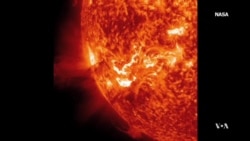One of the first discoveries of the space age, made in 1958, was that the Earth is surrounded with a doughnut-shaped field of highly charged particles. It was named the Van Allen radiation belt, after its discoverer, U.S. space scientist James Van Allen. But not much was known about it until NASA launched two probes in 2012. Scientists say the data they sent back to earth is very exciting.
Space weather can be as unpredictable as the weather on earth. Periodic eruptions on the sun's surface eject huge clouds of highly charged protons and electrons.
Some of them reach the earth and cause spectacular light displays like the Aurora Borealis or Northern Lights.
When the clouds of charged particles are unusually strong, they can knock out power grids, disrupt communications and even damage electronic equipment.
But most of the time they get trapped by the earth’s magnetic field in the so-called the Van Allen radiation belt.
Nevertheless, they can still inflict damage, says NASA’s program scientist, Mona Kessel.
"We also have a lot of satellites that fly through that area - communications satellites, navigation satellites - and so we need to understand what it is that the effects are, because the effects can be quite dramatic," said Kessel.
To learn more about space weather, NASA in 2012 launched a pair of satellites built by Applied Physics Laboratory. Called Van Allen Probes, they were to explore the mysterious belt. At first researchers expected only quantitative data, says project scientist Barry Mauk.
“I was skeptical we would find anything surprising. In fact, we found tremendous surprise. We found new structures that we never anticipated," said Mauk.
The Van Allen Probes discovered that, instead of two layers, the belt has an occasional third layer of charged particles and that they sometimes form zones called ‘zebra stripes’. The probes also found how the electric and magnetic fields additionally energize the particles.
Mauk says measurements gathered by the two probes will help scientists develop computer models for creating space weather forecasts.
“If I see something at the sun, some flare or something, and I can measure the magnetic field on the sun - there are remote ways of doing that - I can now predict how will the radiation belts respond to that," he said.
And that, he says, may lead to sending the astronauts to their vaults or powering down the communication and navigation satellites while this effect passes by.
"And then we also just want to understand it because it's a very dynamic part of our whole space, above the earth, our electromagnetic space," said Kessel.
Scientists say better understanding of the Van Allen radiation belt will help us prepare for potential surprises from our own sun.






